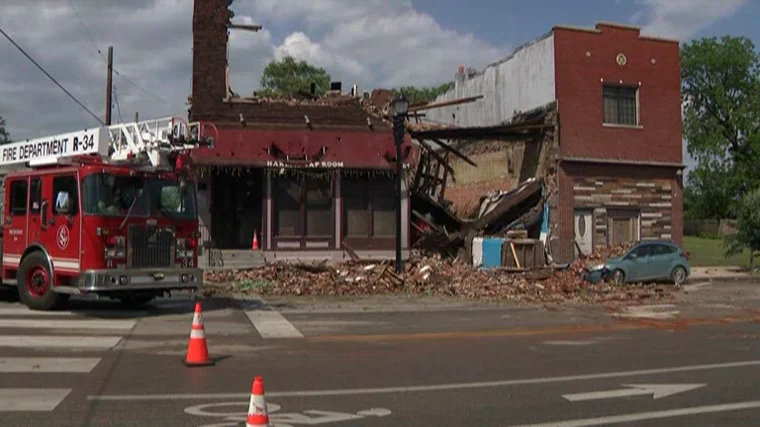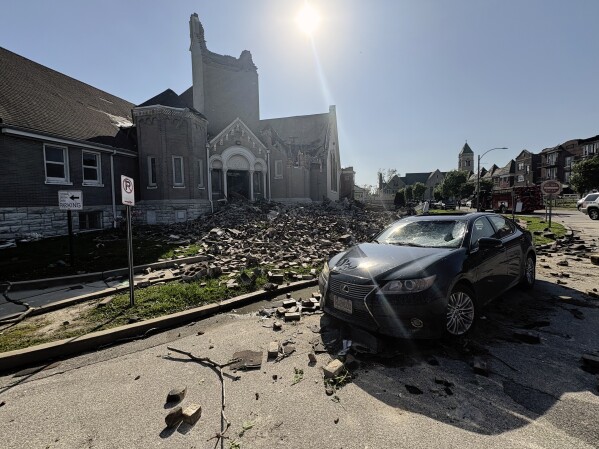
A powerful tornado tore through parts of St. Louis on May 15, 2025, leaving a trail of devastation and claiming the lives of five people. This tragic event is part of a larger outbreak of severe weather sweeping across the central United States, intensifying concerns over springtime storms that have already caused extensive damage in multiple states. The aftermath of the tornado has left communities grappling with loss, destruction, and urgent recovery efforts, as meteorologists warn that this severe weather pattern may continue for the foreseeable future.
St. Louis Tornado Hits with Unexpected Ferocity
The tornado struck the St. Louis metropolitan area in the late afternoon, catching many residents off guard despite warnings issued earlier in the day. According to the National Weather Service, the tornado reached EF3 intensity, with wind speeds exceeding 140 miles per hour, strong enough to uproot trees, destroy homes, and overturn vehicles. The sudden surge of violent winds brought down power lines and caused widespread outages, further complicating rescue and relief operations.
Eyewitnesses described scenes of chaos and devastation as the twister carved through neighborhoods, leaving behind shattered buildings and scattered debris. “It sounded like a freight train coming through,” one local resident recalled. “Within minutes, everything changed — the sky went dark, and the wind just ripped through the streets.”
Meteorologists noted that while the central US is no stranger to springtime tornadoes, the intensity and speed of this particular storm were unusually severe. Radar data showed the storm system developing rapidly, giving residents less time to prepare than usual. This has sparked discussions about the limitations of current weather prediction technology and the urgent need for improvements to ensure timely alerts.
Five Confirmed Fatalities and Multiple Injuries
Tragically, the tornado resulted in the deaths of five individuals, including two children and a senior citizen. Emergency responders have been working tirelessly to locate and assist those trapped in damaged homes and vehicles. Hospitals in the region have reported receiving dozens of patients with injuries ranging from minor cuts to severe trauma caused by flying debris.
Authorities are continuing to assess the full extent of the casualties, emphasizing that the toll could rise as search and rescue teams reach more isolated areas. Governor Michelle Reynolds of Missouri declared a state of emergency, mobilizing the National Guard and federal disaster relief agencies to assist with recovery and humanitarian aid.
Local officials have commended the bravery of first responders, who faced immense challenges during their rescue operations. Stories of neighbors helping neighbors and strangers pulling together to assist in the chaos highlight the resilience and solidarity of the St. Louis community in the face of tragedy.
Widespread Damage Disrupts Daily Life
Beyond the heartbreaking loss of life, the tornado’s destruction has left thousands without shelter and essential services. Entire blocks of residential homes have been reduced to rubble, while commercial districts sustained significant damage to buildings and infrastructure. Power outages have affected over 100,000 customers, leading to disruptions in communication, transportation, and access to clean water.
Local schools and businesses announced closures, with many expected to remain shut for weeks as cleanup efforts get underway. Community centers and relief organizations have opened their doors to displaced families, offering food, shelter, and medical assistance.
One of the hardest-hit areas was the suburban town of Hazelwood, where entire neighborhoods were flattened. Residents expressed shock and disbelief as they surveyed the ruins of their homes. “I’ve lived here for 20 years, and I’ve never seen anything like this,” said Michael Sanders, whose house was completely destroyed. “We’ve lost everything, but we’re grateful to be alive.”
Severe Weather Pattern Continues Across Central US
The tornado in St. Louis is part of a broader severe weather system currently affecting a wide swath of the central United States. Meteorologists report that a series of powerful storm fronts moving eastward have created unstable atmospheric conditions conducive to tornado formation, damaging hail, and intense thunderstorms.
Other states such as Oklahoma, Kansas, and Arkansas have also experienced severe weather outbreaks, with flash floods, high winds, and smaller tornadoes reported. Weather experts warn residents in vulnerable areas to remain vigilant and heed safety advisories issued by the National Weather Service.
Climate scientists have raised concerns about the increasing frequency and intensity of severe weather events in recent years. While tornadoes are a natural phenomenon, some researchers believe that rising global temperatures and changing atmospheric patterns may be contributing to more volatile weather conditions. These findings underscore the importance of investing in climate adaptation and mitigation strategies.
The current weather pattern, driven by a combination of atmospheric instability and high moisture levels, has created conditions ripe for severe thunderstorms. Experts are particularly concerned about the possibility of additional tornado outbreaks as this storm system continues to track eastward. Communities in the path of the storm are being urged to take precautions and stay alert to changing weather conditions.
Emergency Response and Community Solidarity
In the wake of the disaster, first responders have been working around the clock to provide emergency care and restore order. Firefighters, paramedics, police officers, and volunteers are coordinating efforts to clear debris, conduct search-and-rescue missions, and distribute essential supplies.
Community members have also stepped up, organizing fundraisers, blood drives, and donation campaigns to support those affected. Social media platforms have been flooded with messages of solidarity and offers of help, reflecting the resilience and compassion of the St. Louis community.
Mayor Jonathan Hayes emphasized the importance of unity during this challenging time. “We are deeply saddened by the loss and destruction caused by this tornado. But our strength lies in coming together, supporting one another, and rebuilding our city,” he said in a public address.
Relief organizations such as the Red Cross and Salvation Army have established temporary shelters and supply centers across the region. Volunteers are working tirelessly to provide meals, clothing, and emotional support to displaced residents. Local businesses have also joined the effort, donating resources and funds to aid recovery efforts.
Stories of heroism have emerged in the aftermath of the tornado. One local teacher, Sarah Martinez, used her car to transport injured neighbors to a nearby hospital after roads became impassable for ambulances. “In times like these, we have to look out for each other,” she said. “It’s what makes us strong.”
The Science Behind Tornado Formation in Spring
Spring is notorious for producing some of the most violent weather phenomena in the United States, with tornadoes frequently occurring in what is known as Tornado Alley. The central US is especially prone due to the unique convergence of warm, moist air from the Gulf of Mexico and cold, dry air from the Rockies and Canada.
When these air masses collide, they create unstable atmospheric conditions, including severe thunderstorms capable of spawning tornadoes. In recent years, scientists have observed shifts in weather patterns possibly linked to climate change, which some experts believe could increase the frequency and intensity of such storms.
While meteorological advancements have improved tornado prediction, challenges remain in providing accurate and timely warnings. Researchers are exploring innovative technologies, such as machine learning and improved radar systems, to enhance forecasting capabilities and reduce the risk of casualties.
Understanding tornado formation is a complex process that involves analyzing wind shear, atmospheric pressure, and moisture levels. Tornadoes typically form during supercell thunderstorms, which are characterized by rotating updrafts. These storms can produce the type of extreme weather seen in St. Louis, underscoring the need for continuous research and investment in weather science.
Impact on Infrastructure and Economy
The tornado’s impact on St. Louis extends beyond immediate physical damage. Critical infrastructure such as roads, bridges, power grids, and water systems have suffered significant setbacks, complicating relief efforts and economic recovery. Repairing this damage is expected to cost millions of dollars, putting strain on local budgets and insurance systems.
Small businesses, many already recovering from the pandemic, face additional challenges as they deal with property loss and interruptions in operations. Economic analysts predict that the region may experience a temporary downturn due to reduced consumer activity and damaged commercial assets.
The agriculture sector, a vital part of Missouri’s economy, has also been affected, with reports of crop damage and disruptions in supply chains. Farmers are calling for government assistance to recover from the financial losses caused by the storm.
The long-term economic impact of the tornado is expected to include increased insurance premiums and higher costs for rebuilding infrastructure. Experts are calling for state and federal governments to provide financial assistance to affected communities, emphasizing the importance of resilience planning in future disaster recovery efforts.
How Residents Can Stay Safe in Severe Weather
While the recent tornado caught many by surprise, experts stress the importance of preparedness and awareness during severe weather seasons. Residents are urged to develop emergency plans, maintain access to weather alerts, and identify safe shelter locations such as basements or interior rooms away from windows.
Public officials encourage families to assemble emergency kits with essentials like water, food, medications, and flashlights. Staying informed through trusted sources and following evacuation orders can save lives when storms approach.
Educational initiatives aimed at increasing public awareness of tornado safety have gained momentum in recent years. Schools and community organizations are partnering with meteorologists to teach residents how to recognize warning signs and respond effectively to emergencies.
One initiative, known as “Storm Ready,” has been particularly successful in preparing communities for severe weather. The program provides training and resources to help residents understand the science of storms and develop practical safety measures.
National and Federal Support Mobilized
Recognizing the severity of the disaster, federal agencies including FEMA have pledged support to Missouri and neighboring states affected by the storm system. Financial assistance, disaster recovery teams, and mental health resources are being deployed to help communities heal and rebuild.
President Maria Gonzales expressed condolences to the victims’ families and emphasized the government’s commitment to long-term recovery efforts. “We stand with the people of St. Louis during this tragic time. Our priority is ensuring safety, providing aid, and helping the region recover stronger than ever,” she said in a statement.
Federal and state officials are also working to streamline the application process for disaster relief funds, ensuring that affected families and businesses receive timely support. Lawmakers have called for additional funding to bolster disaster preparedness and response capabilities nationwide.
Efforts are also underway to provide mental health support to those affected by the tornado. Counseling services and support groups have been established to help residents cope with the emotional toll of the disaster, highlighting the importance of addressing both physical and psychological needs in recovery.
Looking Forward: Rebuilding and Resilience
As the cleanup begins, residents and officials alike are focusing on rebuilding efforts that prioritize resilience against future storms. Discussions are underway about improving building codes, enhancing early warning systems, and investing in community education to mitigate the impact of similar disasters.
Environmental groups advocate for more research into the links between climate change and extreme weather events, calling for policies that reduce carbon emissions and protect vulnerable ecosystems.
Despite the heartbreak and hardship, the spirit of St. Louis remains unbroken. With coordinated efforts and the support of the nation, this historic city will overcome the devastation and emerge stronger.
The road to recovery will be long, but the lessons learned from this disaster may lead to lasting improvements in disaster preparedness and response. As St. Louis rebuilds, it serves as a reminder of the importance of resilience, community support, and the enduring human spirit in the face of adversity.

